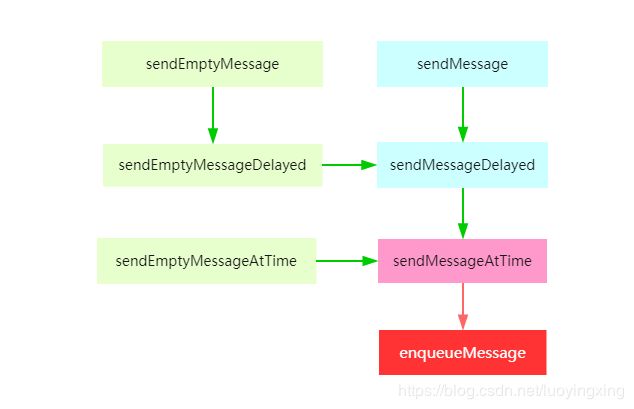android Handler机制原理解析(一篇就够,包你形象而深刻)
首先,我将Handler相关的原理机制形象的描述为以下情景:
- Handler:快递员(属于某个快递公司的职员)
- Message:包裹(可以放置很多东西的箱子)
- MessageQueue:快递分拣中心(分拣快递的传送带)
- Looper:快递公司(具有处理包裹去向的管理中心)
情景分析:在子线程中更新主线程的UI
其中的原理机制可以形象的理解为:
某天,你想给朋友寄一件礼物,首先你拿个箱子装好礼物并包裹好,下单叫了某家的快递员上门取件,快递员揽收你的包裹后,会将包裹送往快递分拣中心,等待配送车送出你的包裹。等配送车来了,就按照你的包裹地址信息,送到指定地方站点,然后分派给相应的快递员,将你的包裹送到你的朋友手里。
这整个邮寄包裹的过程可以形象的理解为Handler的工作机制原理,下面还原一下实际工作过程:
某时,你想刷新主界面的TextView,无奈你不在主线程,此时你就会包装好Message,然后声明一个Handler,让Handler将你的Message送往主线程(Looper),Handler将你的Message送到主线程后,还需要排队等待,等轮到你的时候,主线程就会告诉Handler,这个Message可以处理了,你负责分发一下,于是,Handler将该Message分发到相应的回调或者handleMessage( ) 方法中,于是,你就在该方法中更新了UI。
下面,我对这四位大佬一个个进行介绍。
一、Message(消息)
Message.class位于android.os.包中。Message的构造函数为无参构造方法,且只有一个构造方法;
public Message() { }
除了构造方法可以创建实例对象外,还可以通过内部的静态方法来创建:
static Message obtain()
static Message obtain(Message orig)
static Message obtain(Handler h)
static Message obtain(Handler h, Runnable callback)
static Message obtain(Handler h, int what)
static Message obtain(Handler h, int what, Object obj)
static Message obtain(Handler h, int what, int arg1, int arg2)
static Message obtain(Handler h, int what, int arg1, int arg2, Object obj)
以上几个静态的方法里面都会首先调用第一个方法来创建一个Message对象,我们来看看源码(API 28)
public static final Object sPoolSync = new Object(); //同步锁对象
private static Message sPool; //全局池消息实例
/**
* 从全局池返回一个新的消息实例,允许我们在许多情况下避免分配新对象。
*/
public static Message obtain() {
synchronized (sPoolSync) {
if (sPool != null) {
Message m = sPool;
//......
return m;
}
}
return new Message();
}
如果当前全局池的Message实例不为空,则返回第一个消息实例。所以,大多数情况下,使用obtain()来获得一个Message对象,可以避免消耗更多的内存资源。
对于其他 static obtain( ) 的重载方法,通过源码,可以发现,都是进行赋值操作,没有太多的可讨性。唯一得注意一下的是 obtain(Handler h, Runnable callback)这个静态方法:
/*package*/ Handler target;
/*package*/ Runnable callback;
public static Message obtain(Handler h, Runnable callback) {
Message m = obtain();
m.target = h;
m.callback = callback;
return m;
}
可以看到,也是赋值操作,target是保护级别的成员变量,即只有同包名空间可以访问,此变量意义重大。除了target,还有一个callback,这个callback也是配合着Handler来发挥作用的。后面讲到Handler会解释到,请稍安勿躁。
此时,大家先要记住的就几点:
- Message有8个静态方法可以创建Message实例
- Message有两个重要的成员变量,分别为target 和callback,一个是Handler,一个是Runnable。
- Message有4个公开变量what、arg1、arg2、obj 可以存储消息进行传递
- Message还有一个包间成员变量next,它是Message类型,后面会使用到,知道有这个next就行
以上就是Message的基本秘密了,很简单,没有什么复杂的东西(作为一个包裹箱,就是这么简单,能装一些东西,然后附带一些关键信息)。
二、Handler(处理机)
Handler.class也位于android.os包中。Handler英文意思为:处理者,管理者,处理机。它在消息传递过程中扮演着重要的角色,是消息的主要处理者,说白了,就是收消息,最终处理消息(它就像一个快递员,收快递,然后领快递单,派送快递)。
1、Handler的构造方法(API 28)
Handler()
Handler(Callback callback)
Handler(boolean async)
Handler(Callback callback, boolean async)
Handler(Looper looper)
Handler(Looper looper, Callback callback)
Handler(Looper looper, Callback callback, boolean async)
通过源码可以发现,上面的构造方法都是上面一个个往下调用的,第一个调用第二个,第二个调用第三个…所以,我们首先把目光放在最后一个方法上:
public Handler(Looper looper, Callback callback, boolean async) {
mLooper = looper;
mQueue = looper.mQueue;
mCallback = callback;
mAsynchronous = async;
}
这是一个赋值的构造方法。再看另外一个构造方法:
public Handler(Callback callback, boolean async) {
//......
mLooper = Looper.myLooper(); //返回与当前线程关联的Looper对象,在后面Looper会讲到
if (mLooper == null) {
throw new RuntimeException(
"Can't create handler inside thread " + Thread.currentThread()
+ " that has not called Looper.prepare()");
}
mQueue = mLooper.mQueue; //返回Looper对象的消息队列,在后面MessageQueue会讲到
mCallback = callback; //接口回调
mAsynchronous = async; //是否异步
}
public interface Callback {
public boolean handleMessage(Message msg); //这个函数大家都很熟悉了,暂不细说,总之都知道是用来回调消息的
}
整个构造方法的过程中会确立以下几件事:
- 获取当前Handler实例所在线程的Looper对象:mLooper = Looper.myLooper()
- 如果Looper不为空,则获取Looper的消息队列,赋值给Handler的成员变量mQueue:mQueue = mLooper.mQueue
- 可以设置Callback 来处理消息回调:mCallback = callback
Handler是消息的处理者,但是它并不是最终处理消息的那个大佬,它有且只能有一个上级个领导,就是Looper,Handler是将消息上报给Looper(领导),然后排队等待,等Looper(领导)处理完消息了,就会通知Handler去领取消息,给Handler分配任务,Handler拿到消息后在自行往下分发,Handler只能听命与Looper(领导)。
举个实际运用中的情景:
当你需要在子线程中更新主线程的UI时,你就会在当前的Activity下创建一个Handler对象,然后在它的handleMessage() 中更新UI。
private Handler mHandler = new Handler() {
@Override
public void handleMessage(Message msg) {
super.handleMessage(msg);
//... 更新UI
}
};
在你创建这个mHandler 实例的时候,底层做了以下几件事情:
- 1、拿到mHandler所在线程的Looper,当前mHandler是在Activity中创建的,很明显,当前的线程就是主线程,所以 mHandler的成员变量mLooper = Looper.myLooper(),此处就已经将当前的主线程Looper赋值过去了。
- 2、紧接着,判断mLooper 是否为空,明显不为空,所以又会将主线程的消息队列赋值给mQueue。告诉Handler,你要是有消息,就送到这个消息队列中来,我(Looper)会一个个按顺序处理,处理完后我就会告诉你,你再处理。
由此我们可以得出结论:
1、Handler有且只能绑定一个线程的Looper;
2、Handler的消息是发送给Looper的消息队列MessageQueue,需要等待处理;
所以,如果你在子线程中声明了一个Handler,是不能直接更新UI的,需要调用Handler相关的构造方法,传入主线程的Looper,这样创建的Handler实例,你才能进行UI的更新操作。另外的,需要注意的是,子线程默认是没有开启专属的Looper,所以,在子线程中创建Handler之前,你必须先开启子线程的Looper,否则就会爆出异常,然后GG。从上面贴出的构造方法中的部分就可以知道:
if (mLooper == null) {
throw new RuntimeException(
"Can't create handler inside thread " + Thread.currentThread()
+ " that has not called Looper.prepare()");
}
以上就是创建Handler的过程,有了Handler实例了,怎样传递消息呢?
2、Handler sendMessage()相关的方法(API 28)
首先上一幅图来表明sendXXXMessageXXX()的相互调用关系:

可以看出,当我们调用Handler进行发送消息时,最终都会调用sendMessageAtTime()方法,最后调用enqueueMessage( ) 发送到消息队列。
public boolean sendMessageAtTime(Message msg, long uptimeMillis) {
MessageQueue queue = mQueue; //获得当前的消息队列
if (queue == null) { //若是在创建Handler时没有指定Looper,就不会有对应的消息队列queue ,自然就会为null
RuntimeException e = new RuntimeException(
this + " sendMessageAtTime() called with no mQueue");
Log.w("Looper", e.getMessage(), e);
return false;
}
return enqueueMessage(queue, msg, uptimeMillis);
}
private boolean enqueueMessage(MessageQueue queue, Message msg, long uptimeMillis) {
msg.target = this; //这个target就是前面我们说到过的
if (mAsynchronous) {
msg.setAsynchronous(true);
}
return queue.enqueueMessage(msg, uptimeMillis);
}
- msg.target = this
在发送消息到消息队列之前,明确的指定了消息的target为当前的Handler,以便于在后面Looper分发消息时用到。 - queue.enqueueMessage(msg, uptimeMillis)
然后调用了消息队列的enqueueMessage()方法,并传递了两个参数,一个Message,一个是long型的时间。
以上就是Handler的创建和发送消息的过程。
3、Handler dispatchMessage()方法(API 28)
前面说了消息的发送,交给Looper等待处理,处理完后会重新通知Handler处理,那么,是怎样通知Handler处理消息的呢?秘密就在dispatchMessage()这个方法中:
/**
* 在这里处理系统消息
*/
public void dispatchMessage(Message msg) {
if (msg.callback != null) {
handleCallback(msg);
} else {
if (mCallback != null) {
if (mCallback.handleMessage(msg)) {
return;
}
}
handleMessage(msg);
}
}
/**
* 子类必须实现这个来接收消息
*/
public void handleMessage(Message msg) {
}
当Looper处理完Message后,会使用到Message的target,即上面说到的target,即发送消息的那个Handler,Looper会调用Handler的dispatchMessage()方法分发消息,所以前面在enqueueMessage()发送消息的时候,为什么非得指明Message的target就是这个道理。
回到dispatchMessage()这个方法:
1、首先会判断Message的callback是否为空,此处的callback就是前面我们在Message中说到的,在静态方法创建Message时,可以指定的callback,若不为空,则将结果回调到callback中;
2、若Handler的mCallback 不为空,也一样的道理。
3、平时我们都没有传入这个callback,而是直接实现handleMessage()这个方法,在这个方法中处理更新UI任务。
以上就是Handler发送和接收消息的基本过程:把消息发送到队列—>然后喝茶等待—>接收消息—>分发消息—>在回调中处理。
三、MessageQueue
前面我们知道,Handler发送消息会调用MessageQueue的enqueueMessage()方法,直接上源码(API 28):
boolean enqueueMessage(Message msg, long when) {
if (msg.target == null) { //判断msg的所属Handler
throw new IllegalArgumentException("Message must have a target.");
}
//......
synchronized (this) { //因为是队列,有先后之分,所以用了同步机制
//......
msg.when = when;
Message p = mMessages; //对列中排在最后的那个Message
//......
if (p == null || when == 0 || when < p.when) {
//若队列为空,或者等待时间为0,或者比前面那位的等待时间要短,就插队
msg.next = p; //此处的next就是前面我们在Message提到的,指向队列的下一个结点
mMessages = msg;
//......
} else {
//......
Message prev;
for (;;) {
//此处for循环是为了取出一个空的或者when比当前Message长的一个消息,然后进行插入
prev = p;
p = p.next;
if (p == null || when < p.when) {
break;
}
//......
}
msg.next = p; // 置换插入
prev.next = msg; // 置换插入
}
//......
}
return true;
}
以上就是消息队列插入消息的过程原理,通过单向链表的数据结构来存储消息。既然有了插入消息的方法供Handler插入消息,那么应该有对应的取出消息的方法,供Looper调用取出消息处理,它就是Message next()这个方法,代码就不贴了,自行前往查看,过程还是挺简单的。
四、Looper
Looper在Handler机制中扮演着关键的一环,他是循环处理消息的发动机,永不停息(永动鸡),它不断的从消息队列中取出的消息,处理,然后分发处理事件。每个线程都可以且只能绑定一个Looper。主线程之所以能处理消息,也是因为在APP启动时,在ActivityThread中的main()方法中就已经启动了Looper循环。
点击前往查看Looper在main()方法中的启动流程
下面直接上Looper关键方法loop( )的源码(API 28)
public static void loop() {
final Looper me = myLooper(); //获得当前的Looper
if (me == null) {
throw new RuntimeException("No Looper; Looper.prepare() wasn't called on this thread.");
}
final MessageQueue queue = me.mQueue; //获取当前Looper的消息队列
//......
for (;;) {
Message msg = queue.next(); //取出队头的消息
if (msg == null) {
// 如果消息为空,则跳过,继续执行下一个message
return;
}
//......
try {
msg.target.dispatchMessage(msg);
//......
} finally {
//......
}
//......
msg.recycleUnchecked(); //回收可能正在使用的消息
}
}
由此可见,Looper的处理消息的循环还是挺简单的,就是拿出消息,然后分发,然后回收 … …